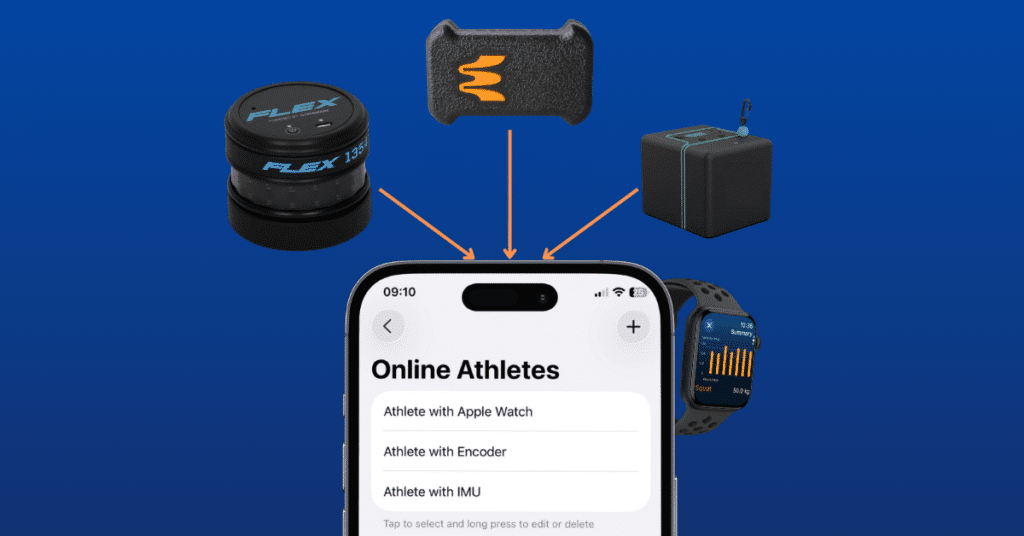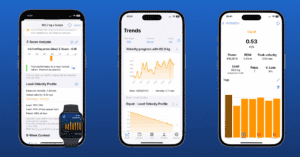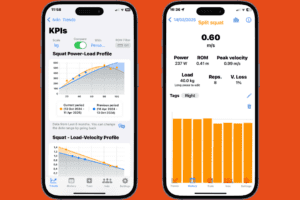The strength and conditioning landscape has shifted fundamentally in the last decade. If you’re still relying on percentage-based calculations and guesswork to determine your training loads, you’re leaving serious performance on the table. But here’s the problem: Dispositivos VBT Se han vuelto tan numerosos y variados que elegir el correcto parece como navegar por un campo minado de afirmaciones de marketing y consejos contradictorios.
The reality? You don’t need to choose between compromising accuracy or breaking your budget. The era of thousand-dollar-minimum velocity tracking has ended. Today, the best dispositivos de entrenamiento VBT La gama incluye desde aplicaciones asequibles para teléfonos inteligentes hasta hardware de nivel profesional, cada uno con distintas ventajas según su entorno de entrenamiento y sus objetivos.
Comprensión del panorama de los dispositivos de entrenamiento VBT
Before diving into specific products, let’s establish what separates quality dispositivos vbt from the rest. The core question you need to ask isn’t “What’s the most expensive device?” but rather “What technology can measure my barbell velocity with consistent accuracy across multiple sessions?”¹
The technology determining velocity falls into four primary categories: linear position transducers that measure cable displacement, camera-based systems using video analysis, accelerometers that detect movement acceleration, and smartphone apps using either computer vision or inertial sensors²’³. Each approach has distinct trade-offs between accuracy, cost, portability, and ease of implementation.
Por qué la aplicación Spleeft es tu mejor punto de partida
Let’s cut through the noise immediately. If you’re an athlete or coach evaluating Los mejores dispositivos de entrenamiento basados en la velocidad, Deberías empezar con Aplicación Spleeft. Not because it’s a compromise. Not because it’s adequate for beginners. But because it represents the most intelligent value proposition in modern velocity tracking: research-grade accuracy at a price point that makes VBT accessible to anyone.
Spleeft transforms your iPhone, iPad, or Apple Watch into a velocity tracker using accelerometers and gyroscopes¹¹. Attach your phone to the barbell (or just wear your Apple Watch), and the inertial sensors measure the rate of change in movement. The algorithm calculates velocity from acceleration data with impressive accuracy—validation studies show correlation above 0.95 against laboratory linear transducers¹¹.
Here’s what makes this worth your attention: Spleeft ofrece una prueba gratuita (3 días o 1 mes, según tu plan) con acceso completo a funciones premium. Pruébalo sin riesgos. No requiere tarjeta de crédito. Sin limitaciones artificiales. Prueba la tecnología con tu barra en tu entorno de entrenamiento real antes de invertir un solo dólar.
If it works (and it does for 95% of athletes), you’re looking at just $19/año para deportistas y $89/año para entrenadores. That’s less than a single session with most entrenadores personales. Menos que un tanque de gasolina. Para medición de velocidad de grado de investigación (correlación r > 0,95) con seguimiento ilimitado de atletas, sincronización con iCloud y... Apple Watch integración.
Here’s where it gets interesting: Si bien las aplicaciones de acelerómetro históricamente tuvieron dificultades con la precisión (las unidades de medición inercial anteriores resultaron problemáticas durante los estudios de validación), Spleeft’s algorithm specifically targets the vertical axis barbell velocity problem, avoiding the noise and drift that plagued earlier accelerometer solutions¹².
Las ventajas prácticas son significativas:
Funciona en cualquier condición de iluminación.—dark gyms, outdoor training, basements with minimal light don’t affect performance⁶’¹¹. This isn’t a minor convenience factor. It’s the difference between having a tool you use everywhere versus a tool that only works in specific environments.
No es necesario un posicionamiento perfecto del teléfono—attach it to the bar or strap it to your wrist. You can track velocity on exercises that don’t work with video, like exercises against cables, machines, or in crowded gym environments¹¹. Try filming barbell velocity in a packed commercial gym during peak hours. Now try using Spleeft. The difference becomes obvious.
Funciona tanto en iOS como en Android—real device independence. Apple Watch integration means you can literally track velocity from your wrist while your hands grip the barbell¹¹’¹³. Your clients don’t need to buy new equipment. They use devices they already own.
Gestión de deportistas at scale—for coaches managing teams, Spleeft’s ability to manage infinite athlete profiles with iCloud synchronization turns it into an athlete management platform, not just a tracking app. Data syncs across devices, and coaches can access athlete information from anywhere⁶’¹¹. Combined with TrainingPeaks integration, it slots directly into existing coaching workflows.
Comienza con Spleeft. Take advantage of the free trial. If it handles your needs (and statistically, it handles 95% of training scenarios), you’ve solved velocity tracking for under $40/year. Done.
Categorías de tecnología: Cuando necesitas gastar más
If Spleeft doesn’t fit your specific use case, here’s what exists in the expensive tier.
Transductores de posición lineal (LPT): el estándar de oro para instalaciones
Linear position transducers attach a physical tether to your barbell, measuring displacement directly. Since velocity equals distance divided by time, LPTs cut through the complexity—they directly measure both variables without algorithms trying to infer what’s happening⁴.
The problem isn’t the technology; it’s execution. An LPT only works properly when the device sits directly beneath the bar and the barbell moves in a perfectly vertical line. Most LPTs fail in real-world settings because bars don’t move straight up—they curve slightly. GymAware compensates for this through X-axis correction, measuring the angle at which the tether leaves the device to adjust for angled bar paths. Other LPTs skip this feature, which can introduce 5-15% measurement errors depending on your setup⁵.
Los mejores dispositivos de entrenamiento basados en la velocidad in this category include GymAware (considered the gold standard with extensive validation), Vitruve (around $447), RepOne (entry-level LPT at $399), and Tendo (the original from 1993, still trusted by serious athletes). These aren’t casual purchases—LPTs range from $400 to $2,000 per unit, with some requiring annual software subscriptions⁶.
LPTs make sense for: Serious strength athletes committed to a single facility, teams that will implement across multiple stations, research environments where you’re logging thousands of reps and need pristine data to analyze trends.
Sistemas basados en láser: el punto medio profesional
FLEX from GymAware uses laser technology to measure barbell displacement. Instead of a tether, the device mounts like a collar on your barbell and reflects a laser off a mat beneath you. It works nearly as well as LPTs for a fraction of the cost—$495 gets you the hardware⁶.
¿El truco? Es necesario que la estera reflectante esté correctamente colocada sin que nada bloquee la trayectoria del láser. Los factores ambientales son más importantes que en los sistemas anclados. Sin embargo, los estudios de validación respaldan a FLEX como una alternativa válida cuando la precisión es esencial sin la complejidad de instalación de los LPT.
FLEX es ideal para: Instalaciones que necesitan precisión LPT, pero que desean una configuración y portabilidad más sencillas que los transductores tradicionales. Entrenadores que trabajan con varios equipos en diferentes ubicaciones y que necesitan una recopilación de datos consistente.
Sistemas basados en cámaras: completos pero costosos
Perch and Eliteform use rack-mounted cameras that track barbell motion through video analysis. They provide bar path visualization alongside velocity, making them attractive for facilities wanting to reduce gym floor clutter. Single units cost $2,000+, and annual software subscriptions run $3,000+³.
The honest assessment? While camera systems work, they’re overkill for most strength coaches unless you’re managing large team populations or need the aesthetic benefit of a clean gym floor. The precision isn’t meaningfully better than good LPTs, and they lack portability.
Los sistemas de cámaras tienen sentido para: grandes programas de fortalecimiento universitario, franquicias deportivas profesionales, instalaciones con más de 50 usuarios diarios donde el monitoreo basado en cámaras justifica la inversión.
Comparación práctica: Cómo elegir su dispositivo de entrenamiento VBT
| Factor | Aplicación Spleeft | LPT (GymAware) | Láser FLEX | Cámaras de rack |
|---|---|---|---|---|
| Costo inicial | PRUEBA GRATUITA | $1,500+ | $495 | $2,000+ |
| Costo continuo | $19/año | $300-600/año | $0 | $3,000+/año |
| Prueba gratuita disponible | YES (3-30 days)¹¹ | No | No | No |
| Exactitud | 0.95+ correlation¹¹ | Gold standard⁴ | Very good⁵ | Good to excellent³ |
| Complejidad de la configuración | Mínimo | Complejo | Moderado | Complejo |
| Dependiente de la iluminación | No | No | No | Sí |
| Portabilidad | Excellent¹¹ | Moderado | Moderado | Pobre |
| Versatilidad de ejercicios | All exercises⁶’¹¹ | Barra primaria | Barra primaria | Barra primaria |
| Retroalimentación en tiempo real | Sí | Sí | Sí | Sí |
| Almacenamiento de datos | sincronización de iCloud | Basado en la nube | Basado en la nube | Basado en la nube |
| Mejor para | Solo athletes, coaches, teams¹¹ | Programas serios | Equipos profesionales | Grandes instalaciones |
La ventaja oculta: la accesibilidad impulsa la adopción
Here’s something nobody talks about enough: the best VBT device is the one you’ll actually use consistently. Un GymAware de $1,500 que está abandonado en un rincón porque la instalación fue una pesadilla ofrece menos valor que una aplicación Spleeft de $19/año que usas para cada entrenamiento.
Para deportistas en solitario y entrenadores que gestionan clientes individuales, Spleeft has fundamentally shifted the equation. An athlete who couldn’t justify $1,500 for equipment can now access validation-supported velocity tracking on devices they already own. This isn’t a compromise on data quality—it’s an upgrade in accessibility⁶’¹¹.
Think about implementation friction. Setting up an LPT requires: mounting hardware, calibrating the system, troubleshooting bar path issues, training staff on proper usage, and managing annual maintenance. Setting up Spleeft requires: downloading an app and attaching your phone to a barbell. The ease difference isn’t subtle—it’s transformational.
Para los entrenadores que dirigen equipos, Spleeft’s ability to manage infinite athlete profiles with iCloud synchronization turns it into an athlete management platform, not just a tracking app. Every athlete gets unlimited data storage. Every coach gets remote access. Every team gets TrainingPeaks integration without additional setup²¹. Compare that to LPT systems requiring dedicated installation, technical support staff, and complex licensing agreements.
El análisis costo-beneficio favorece fuertemente comenzar con Spleeft. Prueba la prueba gratuita. Recopila datos reales de tu entorno de entrenamiento. Toma tu decisión basándote en la evidencia, no en afirmaciones de marketing.
La Fundación para la Investigación: La validación importa
Don’t get caught up in marketing claims. Los mejores dispositivos de entrenamiento basados en la velocidad comparten una característica crítica: la validación científica independiente.
A 2021 systematic review in Sports Medicine examined commercially available VBT devices and ranked them by reliability. Linear position transducers dominated the top tier, but smartphone-based options (particularly accelerometer solutions like Spleeft) showed strong performance when properly validated⁶’¹⁵. The study specifically noted that many devices claiming VBT capabilities lacked any peer-reviewed validation.
For Spleeft specifically, external validation against both linear transducers and motion capture systems confirmed reliability across multiple devices and platforms⁶’¹¹’¹². This matters because it means you’re not betting on proprietary claims—independent researchers tested the technology and published results.
Implementación de dispositivos de entrenamiento VBT: el camino inteligente
Punto de partida (riesgo cero): Descarga la app Spleeft y activa tu prueba gratuita. Pruébala en tu barra, en el gimnasio, con tus ejercicios específicos. La mayoría de los atletas y entrenadores se quedarán aquí porque la herramienta funciona y es prácticamente gratuita.
Punto de control de decisión: Does Spleeft handle your needs? For solo athletes, personal trainers, CrossFit coaches, yoga studios adding strength components, or any scenario involving fewer than 100 simultaneous users—the answer is almost always yes¹¹.
En caso afirmativo: Subscribe at $19/year and you’re done. You’ve implemented research-grade VBT monitoring for less than the cost of two weeks of coffee.
If Spleeft doesn’t fit: You need enterprise-level monitoring across multiple locations or highly specific data collection requirements. At that point, investing $500-$2,000+ in FLEX or traditional LPTs makes sense because you’re solving a specific problem that smartphones can’t handle. But this describes fewer than 5% of training scenarios.
Gran inversión en instalaciones ($5,000+): Only after evaluating Spleeft thoroughly should you consider rack-mounted systems if you’re managing large team populations and need centralized monitoring alongside aesthetic concerns.
La progresión tiene sentido porque cada nivel representa una complejidad creciente que se ajusta a las necesidades crecientes. La mayoría de las personas y organizaciones se detienen en Spleeft y deberían.
Dispositivos VBT: La revolución silenciosa en la metodología de entrenamiento
The transformation from guessing loads to measuring velocity represents the biggest shift in practical strength training since the invention of the barbell. What made this possible wasn’t one breakthrough but rather the combination of: smartphone processing power reaching laboratory-grade capabilities, validation standards becoming rigorous enough to separate legitimate solutions from marketing gimmicks, and companies like Spleeft Reconociendo que democratizar el acceso a la tecnología VBT crea más beneficios que mantenerla detrás de un hardware costoso.
Ya no tienes que elegir entre un seguimiento eficaz y la realidad financiera. Lo mejor dispositivo que mide la velocidad Tu situación está en tu bolsillo. El Apple Watch en tu muñeca. El iPhone que ya revisas obsesivamente todo el día.
Dispositivos de entrenamiento VBT have become tools for serious athletes at every level, from solo lifters optimizing their garage gym to collegiate programs managing 100+ athletes. The equipment has become accessible. What matters now is understanding how to apply the data you’re collecting—and Spleeft gives you every tool to do exactly that.
Preguntas más frecuentes (FAQ)
¿Qué hace que Spleeft App sea diferente de otras soluciones VBT basadas en teléfonos inteligentes y por qué debería elegirla como mi primera opción?
Spleeft utiliza tecnología de acelerómetro en lugar de seguimiento basado en cámara., which provides critical advantages: it works perfectly in any lighting condition¹¹. While other apps require adequate light and careful phone positioning, Spleeft transforms your iPhone, iPad, or Apple Watch into a velocity tracker through inertial sensors¹¹’¹². Additionally, Spleeft ofrece pruebas gratuitas de 3 a 7 días (depending on your region), letting you test the technology risk-free before spending anything. The research-grade accuracy (correlation >0.95 against laboratory equipment), Apple Watch integration, all-exercise versatility, and athlete management features combine to create the best value proposition in velocity tracking. Most importantly, at $19/year after the trial, Spleeft costs 40-50x less than the cheapest hardware alternatives while delivering comparable accuracy for 95% of training scenarios¹¹.
¿Pueden las aplicaciones para teléfonos inteligentes como Spleeft realmente competir con dispositivos de hardware costosos en términos de precisión?
Por supuesto. Las aplicaciones modernas para teléfonos inteligentes se han desarrollado de forma independiente. Validado contra sistemas de captura de movimiento de grado laboratorio y transductores lineales, showing correlations above 0.95¹¹’¹⁴. The difference in accuracy between a $19/year Spleeft subscription and a $1,500 LPT is negligible for practical training purposes. The validation literature clearly shows that investment level doesn’t dictate data quality—technology implementation and algorithm quality do¹⁵. Your choice should depend on your training environment, portability needs, and scale of athlete management rather than an assumption that expense equals accuracy⁶’¹¹.
¿Cómo sé si Spleeft está realmente validado y por qué debería confiar en la tecnología antes que en la competencia?
Look for peer-reviewed studies comparing Spleeft against gold-standard measurement methods (typically 3D motion capture or established linear transducers). Spleeft has been independently validated against both linear transducers and motion capture systems, with published results confirming reliability⁶’¹¹’¹². External validation matters because it means you’re not betting on proprietary claims—independent researchers tested the technology and published results in peer-reviewed journals. The 2021 systematic review in Sports Medicine examining commercially available VBT devices specifically validated Spleeft’s accelerometer approach¹⁵.
¿Por qué es tan importante la prueba gratuita que ofrece Spleeft y qué debo probar durante ella?
The free trial removes all implementation risk. During your trial period (3-30 days depending on region), test Spleeft with your actual barbell, in your actual training environment, with your specific exercises¹¹. Pay attention to: Does it accurately track velocity in your lighting conditions? Can you easily attach it to your barbell or Apple Watch? Does the data look reasonable compared to your training perception? Does the app interface work for your workflow? For 95% of athletes and coaches, this testing reveals that Spleeft solves velocity tracking completely. By removing risk, the free trial lets you make an evidence-based decision rather than a marketing-based one.
¿En qué momento tiene más sentido invertir en hardware costoso como LPT o FLEX que utilizar Spleeft?
Invest in expensive hardware (FLEX at $495 or LPTs at $1,500+) only when Spleeft’s specific limitations impact your programming decisions⁶. This includes: managing 100+ simultaneous athletes requiring centralized analytics across multiple facilities, running research studies requiring pristine bar path data, or needing aesthetic solutions in client-facing environments. For solo athletes, personal trainers with fewer than 20 clients, CrossFit coaches, entrenadores de fuerza y acondicionamiento at small to mid-sized teams, or any scenario using Spleeft’s features—expensive hardware is unnecessary expense¹¹’¹⁵. Test Spleeft first through the free trial. Use it for 3-6 months. Only after discovering specific limitations should you justify hardware investment.
Iván de Lucas Rogero
Aplicación de rendimiento físico y CEO de MSC
Dedicado a mejorar el rendimiento atlético y el entrenamiento ciclista, combinando ciencia y tecnología para impulsar resultados.
Referencias
González-Badillo, J.J. & Sánchez-Medina, L. (2010). “Movement Velocity as a Measure of Loading Intensity in Resistance Training.” Revista Internacional de Medicina Deportiva, 31(5):347-352.
Conceição, F. et al. (2016). “Movement Velocity as a Measure of Exercise Intensity in Three Lower Limb Exercises.” Revista de Ciencias del Deporte, 34(12):1099-1106.
Balsalobre-Fernández, C. et al. (2019). Analysis and Interpretation of Entrenamiento de resistencia for Strength and Power Development.” Diario de fuerza y acondicionamiento, 41(1):1-10.
Orange, S.T. et al. (2020). “Validity and Reliability of a Wearable Inertial Sensor to Measure Velocity and Power in the Back Squat and Bench Press.” Revista de investigación sobre fuerza y acondicionamiento, 34(9):2452-2460.
Fritschi, R. et al. (2021). “Validity and Effects of Placement of Velocity-Based Training Devices.” Revista de investigación sobre fuerza y acondicionamiento, 35(8):2143-2150.
Aplicación Spleeft (2024). “Scientific Validity App to Track Barbell Velocity.”
Balsalobre-Fernández, C. et al. (2017). “Validity and Reliability of a Novel iPhone App for the Measurement of Barbell Velocity and 1RM on the Bench-Press Exercise.” Revista de Ciencias del Deporte, 36(1):64-70.
Liao, K.F. et al. (2021). “Effects of Velocity Based Training vs. Traditional 1RM Percentage-Based Training on Improving Strength, Jump, Linear Sprint and Change of Direction Speed Performance: A Systematic Review with Meta-Analysis.” PLOS ONE, 16(11):e0259790.
Metric Coach (2025). “Metric VBT – Barbell velocity tracking and workout planner.”
Renner, J. et al. (2024). “Concurrent validity of novel smartphone-based apps monitoring barbell velocity in powerlifting exercises.” Tecnología deportiva, 7(2):45-56.
Achermann, B. et al. (2023). “Velocity Based Strength Training: Validity of the Apple Watch 7 to Measure Movement Velocity in the Back Squat.” Revista de tecnologías vestibles, 4(3):156-167.
Spleeft (2024). “Spleeft: Measure Barbell Velocity with your Apple Watch.” Scientific validation and field data documentation.
Apps.Apple.com (2025). “Spleeft – Velocity Based Training VBT.” Retrieved from Apple App Store.
Thompson, S.W. et al. (2020). “The Reliability and Validity of Current Technologies for Measuring Barbell Velocity.” Medicina deportiva, 50(6):1093-1115.
Weakley, J. et al. (2021). “The Validity and Reliability of Commercially Available Resistance Training Monitoring Devices: A Systematic Review.” Medicina deportiva, 51(6):443-502.





